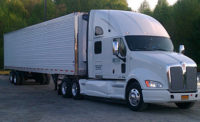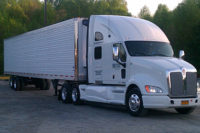Best practices for shipping refrigerated products via rail
Multiple new refrigerated (reefer) rail companies have entered the market in recent years, and existing service providers are investing more capital into developing and expanding their fleets and geographic reach.

Highway congestion, truck driver shortage and rising freight rates are collectively making the use of rail more appealing to shippers. For those who move refrigerated or frozen product, the appeal of trying rail is even higher. The cold chain has a limited supply of equipment, so making the switch from truck to rail opens the door to more capacity.
Multiple new refrigerated (reefer) rail companies have entered the market in recent years, and existing service providers are investing more capital into developing the mode and expanding their fleets and geographic reach. Monitoring and refrigeration technology have also evolved, making reefer rail a more common and appealing option for the movement of perishable goods.
Best situations to consider leveraging rail:
- Long haul shipments over 700 miles.
- Large shipments.
- Shipments that are not extremely time-sensitive.
How reefer rail differs from traditional dry rail:
- Ability to expedite.
- Fewer providers/equipment available.
Making the switch from over-the-road to rail is not complicated, and the protocols for refrigerated truck and refrigerated rail are similar. Here are some examples:
Written specifications. Transport requirements should be outlined clearly to eliminate the chance of misinterpretation. Shippers should include details in the Bill of Lading (BOL) or another official document. Start by clearly communicating specifications for parameters on packaging, loading, stowage, temperature management, sanitation and handling.
- Upper control limit (UCL) or the temperature product cannot exceed.
- Lower control limit (LCL) or the temperature product cannot go below.
- List specific goods that should not be transported in the same trailer.
- Instructions on what to do if temperature goes above/below specifications.
- Safe loading instructions and diagrams.
- Details on how equipment should be sanitized/cleaned.
Pre-chill trailers before loading. A reefer unit is designed to maintain temperature, not change it, so it’s essential that trailers are pre-chilled before they are loaded. Chilling units before loading helps prevent against any heat-related issues. USDA guidelines recommend running the unit 1-2 hours for pre-cooling.
If not pre-chilled before reaching the loading dock, you run the risk of interrupting operation schedules. Product simply cannot go in a trailer until it is at the proper temperature and will need to be chilled before loading.
After being pre-chilled, FSMA guidelines require that refrigeration units are turned off when product is ready to be loaded and before box doors open.
Load and unload quickly. When product thaws and later refreezes, this usually leads to spoilage. Always keep product cool by loading and unloading quickly. Idle time spent with doors open can easily result in product temperature moving below its required range. Product temperature should also be monitored at the time of loading/unloading.
Best practice calls for loading at a dock that is refrigerated with cold tunnels. If loaded in a hot environment, moisture can enter the box and/or temperatures can rise beyond safety parameters.
Once loaded, close doors immediately, re-start the refrigeration unit and re-confirm proper settings.
Utilize proper stacking patterns. Air flow is essential for refrigerated and frozen loads. There are certain steps you can take to properly load product to maintain circulation. Be sure to provide your transportation partners with detailed loading instructions, and if possible, diagrams.
- Do not use slip sheets or any other device that will block vertical airflow.
- Keep product out of direct contact with the ceiling, floor, side and back walls – this helps to minimize the conduction of heat from outside.
- Use bracing to prevent shifting of product, as movement could block air circulation – leverage plastic air bags, load rails, Styrofoam or wooden braces.
- Stack product so there is adequate air circulation – some products require that every box be in direct contact with refrigerated air.
Leverage tracking systems. Monitor the temperature, location and status of your shipments while in transit. Most service providers offer complimentary visibility technology that includes telematics for remote monitoring of location, direction, speed and temperature. Advanced providers have satellite tracking systems that can share real-time aerial shots for accurate location updates and box temperature readings.
Temperature logs are essential for effective issue management and potential claim resolution, as they help verify whether product was kept within a safe range throughout transit.
Review a checklist when loading. “Pre-tripping” is a term that refers to checking and recording key information before a shipment hits the road. This includes:
- Recording of date/time.
- Door seals tightly and is in proper condition.
- Refrigeration unit is working properly.
- Thermostat is properly calibrated.
- Necessary temperature range during transit is known.
- Container is clean and odor-free.
These stats should also be checked again when unloading. The stats recorded at the start of transit should match those at the end.
Develop drayage relationships. The movement of perishable foods cannot be delayed, and the costs associated with keeping a refrigerated box running in a rail yard adds up quickly. It’s imperative to establish quality relationships with reliable drayage providers. This helps keep product moving on schedule, which means fresh food and lower costs.
A third-party logistics (3PL) partner can help set up drayage relationships and manage tight booking schedules. It’s best to work with local providers who are near the rail terminals. Proximity will make the nuanced timing more achievable and make solving problems simpler.
Give reefer rail a try
The refrigerated rail network is continuing to expand, and technology improvements are making the movement of food and medical products easier and safer.
Best practices for reefer rail aren’t radically different than temperature-controlled trucking, so making the switch doesn’t have to be difficult. Work with an experienced service provider who can coach you through the process and ensure shipments are successful.
There really is no time like the present to give reefer rail a try.
Looking for a reprint of this article?
From high-res PDFs to custom plaques, order your copy today!





